Building a Wooden Lobster Boat
John’s Bay Boat Company, Part III
Peter Kass has had a life long interest in wooden boats. Kass still builds one boat at a time. The building methods might be called improved traditional. Some of his crew have been with him for decades.
This photo essay highlights some of the steps in an ages old building process. The work requires high level skills in engineering, intuition, architecture, materials, tools, and a lot of practice. Part III covers planking and parts of the topside. The boat is still being built.
Part IV will cover final details and the May launch. Special thanks to Walt Barrows, a photographer and admirer of Kass’s work, for granting the use of his photographs for this story. The boat in the photos was built in the winter of 2014-2015.
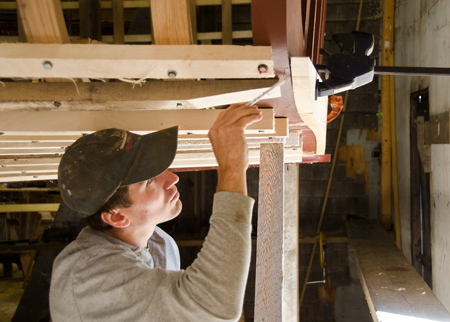
Jeff Hanley tracing a line on the first plank on the boat. The plank will be finish planed to the line. The stern or transom is planked first. Side planks will overlap stern planking.
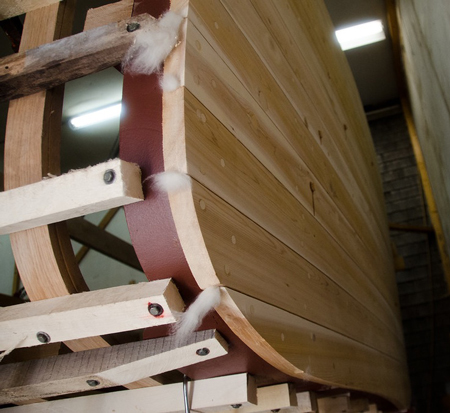
The stern planked, bunged and caulked with cotton. One half the thickness of the plank is flush with its neighbor. The outer half of the upper plank edge is slightly beveled to allow cotton to be driven between the planks with a flat metal caulking iron and later filled with seam compound.
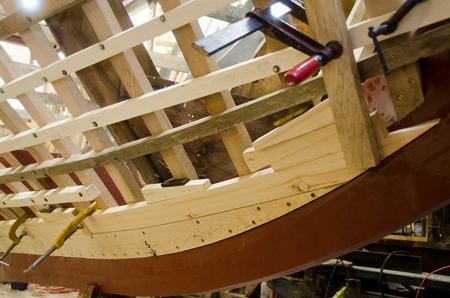
The lower garbopard plank screwed down and the second plank clamped and wedged in place ready to be fastened. Wood wedges are used to drive plank down against rabbet and garboard plank. Black metal planking dog, center, grips frame and enables wedge to be driven against top of plank. Left, planking dog and clamp with pads to protect plank surface.
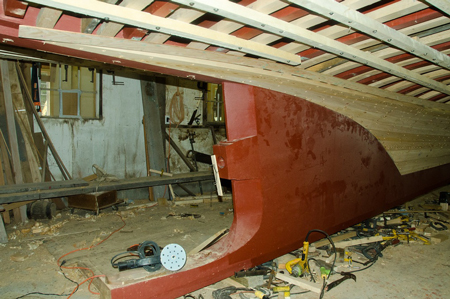
Tuck area planked and fastened. Piece along top plank is a spiling batten used to take off shape of plank below. The space between the plank edge and batten is marked on the batten, then transferred to the next plank to be cut. String on scrap,of wood that runs into shaft hole in keel is made taut to locate where center of shaft will be in order to make cut-outs in floors for the shaft.
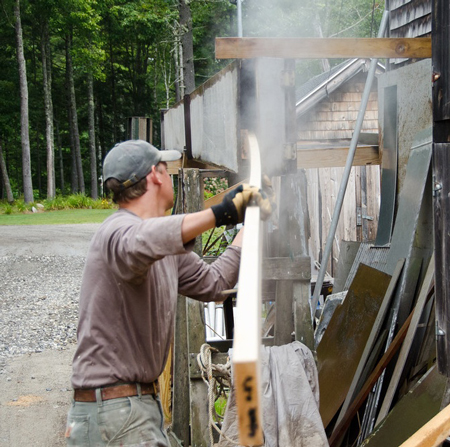
Pulling a hot rubbery white cedar plank from the steamer. All but the butt end cut will have been made.
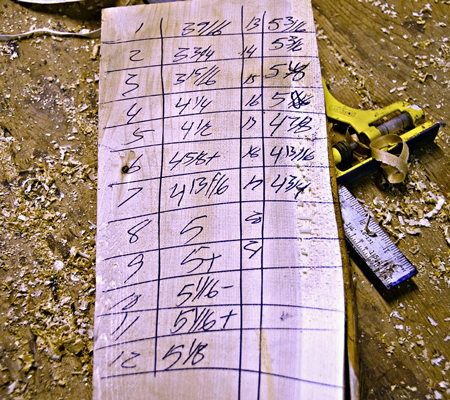
The widths of a single plank at each of 19 frames. Planks are narrower at the stem, wider amidship and narrow at the stern, but wider than at the stem. The distance from the keel to the rail is greatest amidship. Forward planks in a lobster boat with flare are cut to widths that produce the proper appearance. Aft of the 19th frame the planks become more equal in width. Below the turn of the bilge plank width adjustments can more easily be made.
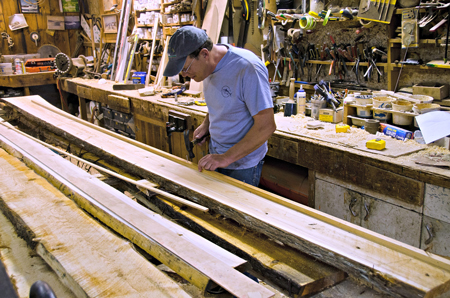
The spiling batten on middle plank in foreground has marks used to transfer the edge shape of an installed plank to the next plank that will fit against it. The marks from the spilling batten have been transferred to the next plank to be installed. Here Peter Kass is tacking a batten to pencil marks taken from the spiling batten to draw a line for cutting the plank with a skill saw or the bandsaw before finishing with a hand plane.
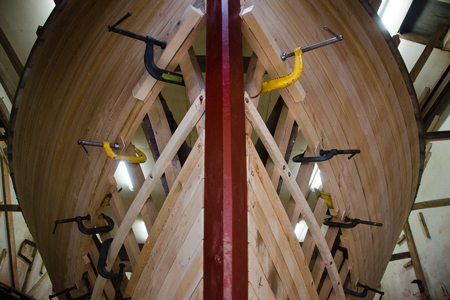
Planking from keel up and rail down toward the last plank at mid-hull. That last plank is called the shutter plank.
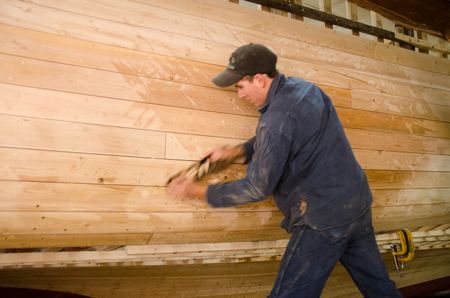
Fairing the nearly completed planking with a jack plane. The outer edges of flat planks at the more curved areas stand proud of the curvature of the frames. Planing fairs the surface into a smooth curve.
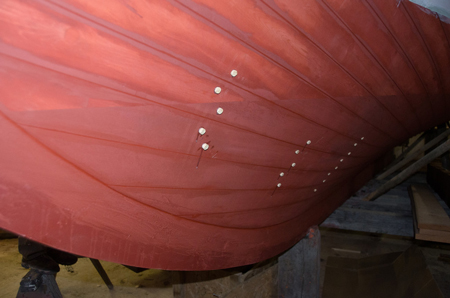
Caulked with cotton strands, the seams primed, then payed with seam compound before priming the whole hull. Last minute cedar bungs to to be shaved flush and painted. The three forward most floors were discovered to fit better against the planks if they are installed after the molds are removed. Hence the late screwed and bunged planks.
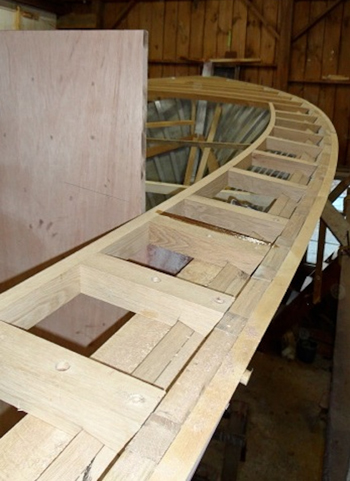
Deck beams center and shear clamp left. Note notches in beams and tight joinery. Frame ends, frame spacers and plank edge at far right.
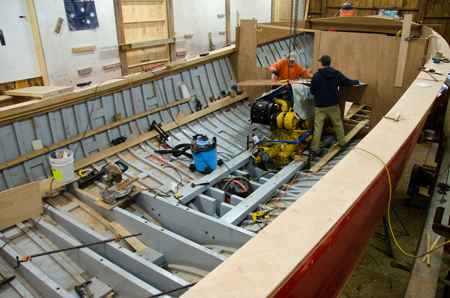
The engine being lowered into position. The boat's forward interior will be built around it. Lower left foreground five deep floors. Two engine beds perpendicular to the floors. Near end of the engine beds U-shaped cutouts in two floors for propeller shaft. The shaft will enter the shaft log 6" in front of the forward most deep floor and behind the floor with the cutout.
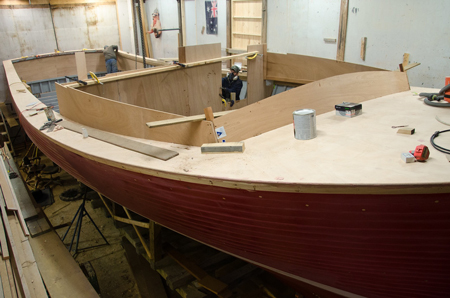
Decks and 3/4" thick mahogany plywood trunk cabin sides. The bulkhead is constructed of two layers of 1/2" mahogany plywood, glued and screwed with staggered joints.
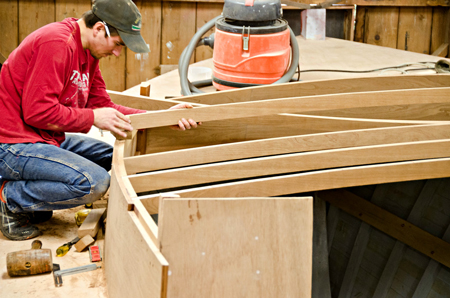
Trimming the ends of cabin top beams for a tight fit. Jeff Hanley with knees against 3/4" mahogany trunk cabin. Bulkhead in foreground is two 1/2" layers of glued and screwed mahogany marine plywood using staggered joints.
